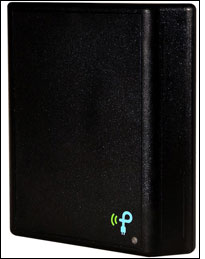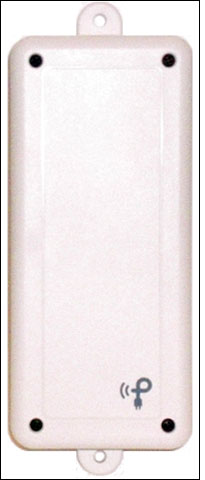Powercast Corp. is marketing active RFID sensor tags that harvest power from RF signals. The system includes an RF transmitter that provides power signals to sensor tags, and a gateway that receives information transmitted by those tags. The company’s focus is on developing solutions for the wireless transmission of sensor data, such as what is required by data centers. In this case, rather than using wired sensors or traditional active RFID tags to send sensor data regarding a room’s conditions, the Powercast system simply uses continuous RF signals to charge a battery or capacitor built into a sensor tag. The solution, known as the Lifetime Power Wireless Sensor System, targets the heating, ventilating and air conditioning (HVAC) sector, as well as other building-controls industries, by providing a solution for acquiring data from sensors for heating and air-conditioning, lighting controls, access controls or other building automation.
Powercast Corp., based in Pittsburgh, was launched in 2003 to develop a system for harvesting wireless power over distances using RF technology. The solution was intended to allow a tag to receive a continuous RF signal from a transmitter, and to store that signal’s energy on a rechargeable battery. The receiving device can then simply utilize the battery’s stored energy for its own functionality, or transmit data and an ID number. The Lifetime Power Wireless Sensor System evolved from a Lifetime Power Energy Harvesting Development Kit, which uses Powercast’s P2110 Powerharvester receiver and was made commercially available in October 2010. The kit included a 3-watt transmitter, a receiver with a built-in battery-charging board, and a micro-energy cell evaluation card, and could be employed to charge devices that transmit data similarly to an active RFID tag. “Our core products have been around RF harvesting,” says Harry Ostaffe, Powercast’s VP of marketing and business development.

According to Ostaffe, the Lifetime Power Wireless Sensor System eliminates the need to wire the device to an external power source, simplifies installation and negates the need for battery replacement, which is required in the case of conventional active RFID tags (see RF Code Debuts Inexpensive Server Tracking Solution and Visual Data Center Combines RFID With 3-D Thermal Imaging).
The company’s Lifetime Power Wireless Sensor System includes a 6.75-inch by 6.25-inch by 1.63-inch RF transmitter box, the TX91501, which sends a 915 MHz signal to power the tags using a proprietary air-interface protocol. The transmitter also transmits fixed, pre-programmed data, amounting to an 8-bit transmitter ID. However, Ostaffe says, a power transmitter could be developed to accept external data input, and then send control information to the sensor nodes. The TX91501 is available with output power of 1 watt for shorter range or 3 watts for longer range.
The wireless sensors can harvest sufficient energy for perpetual operation at a distance of up to 80 feet from the transmitter. The first of the family of sensor devices is the WSN-1001 wireless temperature and humidity sensor. Additional wirelessly powered sensors will follow shortly, the company indicates, designed to measure carbon dioxide, air pressure, light level, motion and other conditions.The sensor tags capture that transmission, and the power is then harvested for storage in either a battery or a capacitor built into the tag. The tag typically includes a microcontroller chip, and can accommodate sensors to measure, for example, light, humidity, motion or temperature. Sensor data is stored on the chip, and once enough power from the RF transmitter is accumulated, the tag transmits that information via a 2.4 GHz signal, compliant with Microchip Technology‘s MiWi proprietary protocol based on the IEEE 802.15.4 standard, to a Powercast Building Automation System (BAS) Gateway. The first version of the gateway comes with a USB interface, and can thus be plugged into a PC to forward data to a user’s building-automation software on that user’s own database. However, other versions will come with interfaces for wired BAS networks such as BACnet, Modbus, Metasys, N2 and LonWorks. The gateway can also support bidirectional communications (that is, from gateway to tag, and vice versa). To conserve power stored by those sensor tags, however, the system is designed only for one-way data transmission—that is, information sent by the sensor tag to the gateway.
The gateway can receive transmissions from the sensor tag up to 120 feet away indoors, and can accommodate up to 100 sensors within its range, as well as 800 sensor points (such as humidity, light or temperature). Users can then use their own software to manage the sensor readings in order to track the conditions within their facility. Powercast provides firmware for the devices themselves, as well as the interface for data received from those devices, which can then be utilized by the back-end software.
Typically, the system is designed with a gateway at the center of a cluster of sensor tags, as well as several transmitters installed around that cluster, thereby focusing their transmission toward the center to guarantee that the most transmission is received. Sensors can be installed behind walls, within rooms and above ceilings, within a range of 120 feet on all sides of the gateway. Although the system is being used predominantly by providers of HVAC control systems for data centers, it is also designed to operate with HVAC systems in offices, hospitals, hotels, apartments or other large buildings.
In addition, Powercast’s energy-harvesting technology can be adapted to recharge other types of devices, such as an iPhone, and power items such as a wireless game controller, a wireless mouse or a keyboard. However, Ostaffe says, the greatest demand is currently for HVAC controls. Because the sensor tags do not require batteries that would need to be replaced, he notes, they can be installed at permanent locations, such as inside walls, where they might be utilized to detect the presence of leaking water.
Powercast’s Lifetime Power Wireless Sensor System has been deployed in pilots by two large HVAC controls companies—one in a hospital and another at a data center. An additional trial, Ostaffe reports, is being prepared by a systems integrator for refrigeration and HVAC monitoring within a hospital environment.


